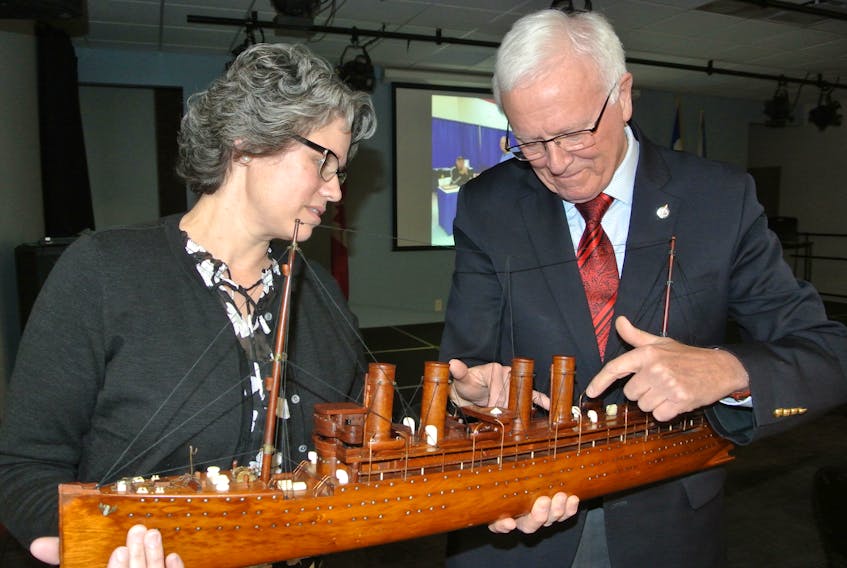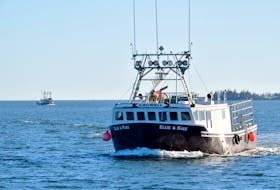AMHERST, N.S. — Bill Casey calls it the ship that talks.
Casey, who will soon retire – again – from politics, remains in awe at the model of a First World War ship, the SS Kaiser Wilhelm der Grosse, that has been in his family for decades and is restored by his nephew, Matt.
“It’s a ship that talks and it has spoken,” Casey said of the ship what was made by a German prisoner of war at the Amherst internment camp a century ago. “The Germans in the camp did a lot of things in Amherst when they were here, but they also made a lot of high quality and beautiful artifacts like toys, furniture, pipe holders, cribbage and more. The workmanship was incredible, and they had no materials to work with. Somehow they produced these artifacts.”
Casey said the model had seen better days. As time passed, the glue had dried and things began falling off of it. He tried to restore it himself, but eventually placed it in a plastic bag and put it on the shelf of his workshop.
“One day, Matthew and I were in my workshop and he looked up and asked ‘what is that?’ I don’t know where my father got it and I regret not asking him before he died, but it has been in the family for as long as I remember,” Casey said. “We brought it down and were looking at the workmanship in it. It was more than a hundred years old and it was in rough shape, but you could still see the work that was put into it, especially when you think they were in an old ironworks and had few tools to work with.”
Casey said it was like the ship was talking to him, saying there should be a 100th birthday for the closing of the internment camp, that was located on the corner of Park and Hickman Street (where Casey Concrete is presently located).
MP Bill Casey restoring ship built by German POW at First World War Amherst internment camp
The largest internment camp in Canada during the First World War, it operated from April 1, 1915 to September 1919. It was home to 853 prisoners of war, including German sailors taken off the Kaiser Wilhelm de Grosse as well as Ukrainians and its most famous prisoner Leon Trotsky, who stayed there for 26 days in April 1917.
“It sent us a message. A hundred years old but still in solid condition,” Casey said.
It was from that he began the process to plan for a centennial celebration on July 2 that will feature the 40-member Luftwaffe band and officials from both the Canadian and German governments.
When he contacted the German embassy in Ottawa they knew nothing about the Amherst camp. “They knew about the camps in Ontario, but nothing about the Amherst camp,” Casey said.
When a German delegation came to Amherst recently they were moved by what they saw at the Amherst cemetery, the Cumberland County Museum and the North Nova Scotia Highlanders Regimental Museum at the Col. James Layton Ralston Armoury.
“We were thinking of bringing a few band members here and a few soldiers to have a ceremony commemorating the 100th anniversary of the closing of the camp. They told us to build a stage for 40 people. They’re sending the entire band. They were so moved that it sent shivers down my spine.
As soon as he saw the ship, Matthew knew he had to restore it and estimates he spent at least 200 hours fixing it up, including using various toothbrushes to clean the wood and animal bone to recreate some of the smaller items on the deck that the original builder had also done in the camp.
“In a way, I scavenged items like he would have a hundred years ago,” Matthew said. “It has taken a lot of time but doing something like this is never a chore. When you think about it, it’s a hundred years old and I just hope that with the work I’ve done that someone will be able to look at it in another hundred years.”
Matthew said he looked at hundreds of photographs of the original ship and Bill was able to secure a copy of the original architectural drawings of the ship. That allowed him to see the detail of every level and it amazed him that the original builder of the model was pretty much bang on with his work.
He also looked other people’s models of the same ship.
It’s Matthew’s work that inspired his uncle to go further to celebrate a piece of Amherst history.
“None of this would’ve happened had Matthew not looked up and saw that ship that then spoke to us about our history,” Casey said, adding it’s just one example of Amherst area history that people have overlooked including the former Acadian village of Beaubassin and the failed Chignecto Marine Ship Railway that attempted to cross the Isthmus of Chignecto.
There are many artifacts from the internment camp. Many of them are located at either the North Nova Scotia Highlanders Regimental Museum in the Col. James Layton Ralston Armoury or at the Cumberland County Museum.
There are probably still items from the camp in households in Amherst.
“We are hoping to gather as many artifacts as we can so we can have them on display,” he said.









